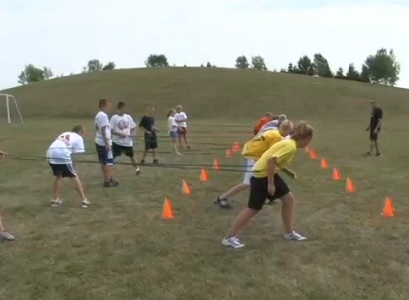Using Bands to Conveniently Impact a Strength & Conditioning Program
Resistance bands are easily the most convenient and effective way to work on first step speed mechanics as it relates to acceleration and deceleration.
Not only are bands easy to attach to the body but their ascending resistance allows athletes to load both acceleration and deceleration phases of running.
7. First Step Acceleration
It’s a well known fact that if an athlete can win the first 3 steps during a play in a game, they are probably going to experience good success continually throughout the game and probably win the event.
Resistance bands make it very easy to train large groups of athletes to increase first step speed and reaction. As a coach, partner-based first step speed training requires minimal setup or space to implement and is relatively easy for athletes to quickly learn.
As for the athlete, they are able to instantly feel the difference it makes on their quickness and agility within only a couple of training sessions. These two factors alone instantly make it successful.
These drills are typically done in a partner attached setup with athletes alternating while performing 3 or 4 sets of 5 reps. Because these drills will emphasize acceleration, the athlete only has to focus on getting out quickly against the band resistance.
Once learned, coaches can build in reaction starts through the use of whistle start hand signals.
Shuffle Acceleration Drill
8. First Step Deceleration
Once acceleration training is mastered, athletes can begin to work on deceleration by training under what is called a pre-loaded band setup. Performing the same drills, athletes now focus on learning how to decelerate under band-driven momentum.
Just like applying weight to increase strength, the band applies a resistance that the body has to overcome in order to become stronger at decelerating or slowing down momentum.
Shuffle Deceleration Drill
9. Partner Resisted Running
Once first step acceleration and deceleration speed drills are mastered, longer amplitude linear speed training can be implemented using a training approach called partner resisted running.
With partner resisted running, partners work together to challenge each other to run under a controlled resistance for 15 to 20 yards.
Partner resisted running allows athletes to now take their first step speed training through longer amplitudes of movement.
Here Is An Example of Partner-Based Forward Running
10. Implementing Non-Traditional Strength Training
The final way that resistance bands can be implemented into an off-season strength program is by using them to simulate non-traditional strength training drills like resisted crawling, towing, pushing or lunging.
In many cases these types of drills are used with specially designed equipment that increases cost and the need for greater training space. With a flat band’s ability to attach onto the body in multiple ways, it allows them to provide resistance to non-traditional movements that, in turn, challenges total body strength and coordination.
Non-Traditional Speed-Strength Training
Flat continuously looped layered bands, like the Quantum Band, provides coaches and their athletes with the ability to train all aspects of performance. They also allow them to simulate specific exercises and unique training approaches that historically required specialized equipment and additional resources.
Resistance band versatility makes it very easy and convenient to implement key aspects of an off-season training program without the need for added equipment, space or resources.
Dave Schmitz – The Band Man
About the Author: Dave Schmitz
 Dave Schmitz (aka…The Band Man) is the Co-Owner of Resistance Band Training Systems, LLC and the creator of https://resistancebandtraining.com, the only website exclusively devoted to training with large continuously looped resistance bands.
Dave Schmitz (aka…The Band Man) is the Co-Owner of Resistance Band Training Systems, LLC and the creator of https://resistancebandtraining.com, the only website exclusively devoted to training with large continuously looped resistance bands.
Dave has a unique professional background and vast experience as an orthopedic physical therapist, performance enhancement specialist, certified strength and conditioning specialist along with 27 plus years of living fitness and performance training.
All of this has allowed him to turn a simple 41-inch resistance band into an incredibly multi-faceted total training experience for 1000’s of athletes and fitness enthusiasts around the world—while helping 100’s of fitness professionals and coaches get their clients or athletes BETTER with BANDS.

 Julie is the Executive Director of the International Youth Conditioning Association (IYCA). She grew up as an athlete and played collegiate softball at Juniata College. She currently owns and operates her own youth fitness business pouring into young athletes. Her areas of expertise are youth sport performance, youth fitness business and softball training/instruction. Julie grew up on a dairy farm and can challenge the best of the best in a cow-milking contest. 😉
Julie is the Executive Director of the International Youth Conditioning Association (IYCA). She grew up as an athlete and played collegiate softball at Juniata College. She currently owns and operates her own youth fitness business pouring into young athletes. Her areas of expertise are youth sport performance, youth fitness business and softball training/instruction. Julie grew up on a dairy farm and can challenge the best of the best in a cow-milking contest. 😉 

